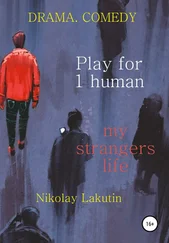Douglas Hofstadter - I Am a Strange Loop
Здесь есть возможность читать онлайн «Douglas Hofstadter - I Am a Strange Loop» весь текст электронной книги совершенно бесплатно (целиком полную версию без сокращений). В некоторых случаях можно слушать аудио, скачать через торрент в формате fb2 и присутствует краткое содержание. Жанр: Прочая документальная литература, на английском языке. Описание произведения, (предисловие) а так же отзывы посетителей доступны на портале библиотеки ЛибКат.
- Название:I Am a Strange Loop
- Автор:
- Жанр:
- Год:неизвестен
- ISBN:нет данных
- Рейтинг книги:4 / 5. Голосов: 1
-
Избранное:Добавить в избранное
- Отзывы:
-
Ваша оценка:
- 80
- 1
- 2
- 3
- 4
- 5
I Am a Strange Loop: краткое содержание, описание и аннотация
Предлагаем к чтению аннотацию, описание, краткое содержание или предисловие (зависит от того, что написал сам автор книги «I Am a Strange Loop»). Если вы не нашли необходимую информацию о книге — напишите в комментариях, мы постараемся отыскать её.
I Am a Strange Loop — читать онлайн бесплатно полную книгу (весь текст) целиком
Ниже представлен текст книги, разбитый по страницам. Система сохранения места последней прочитанной страницы, позволяет с удобством читать онлайн бесплатно книгу «I Am a Strange Loop», без необходимости каждый раз заново искать на чём Вы остановились. Поставьте закладку, и сможете в любой момент перейти на страницу, на которой закончили чтение.
Интервал:
Закладка:
What would it take for a robot vehicle to think such thoughts or have such feelings? Would it suffice for Stanley’s rigidly mounted TV camera to be able to turn around on itself and for Stanley thereby to acquire visual imagery of itself? Of course not. That may be one indispensable move in the long process of acquiring an “I”, but as we know in the case of chickens and cockroaches, perception of a body part does not a self make.
A Counterfactual Stanley
What is lacking in Stanley that would endow it with an “I”, and what does not seem to be part of the research program for developers of self-driving vehicles, is a deep understanding of its place in the world. By this I do not mean, of course, the vehicle’s location on the earth’s surface, which is given to it down to the centimeter by GPS; it means a rich representation of the vehicle’s own actions and its relations to other vehicles, a rich representation of its goals and its “hopes”. This would require the vehicle to have a full episodic memory of thousands of experiences it had had, as well as an episodic projectory (what it would expect to happen in its “life”, and what it would hope, and what it would fear), as well as an episodic subjunctory, detailing its thoughts about near misses it had had, and what would most likely have happened had things gone some other way.
Thus, Stanley the Robot Steamer would have to be able to think to itself such hypothetical future thoughts as, “Gee, I wonder if H1 will deliberately swerve out in front of me and prevent me from passing it, or even knock me off the road into the ditch down there! That’s what I’d do if I were H1!” Then, moments later, it would have to be able to entertain counterfactual thoughts such as, “Whew! Am I ever glad that H1 wasn’t so clever as I feared — or maybe H1 is just not as competitive as I am!”
An article in Wired magazine described the near-panic in the Stanford development team as the desert challenge was drawing perilously near and they realized something was still very much lacking. It casually stated, “They needed the algorithmic equivalent of self-awareness”, and it then proceeded to say that soon they had indeed achieved this goal (it took them all of three months of work!). Once again, when all due hat-tips have been made toward the team’s great achievement, one still has to realize that there is nothing going on inside Stanley that merits being labeled by the highly loaded, highly anthropomorphic term “self-awareness”.
The feedback loop inside Stanley’s computational machinery is good enough to guide it down a long dusty road punctuated by potholes and lined with scraggly saguaros and tumbleweed plants. I salute it! But if one has set one’s sights not just on driving but on thinking and consciousness, then Stanley’s feedback loop is not strange enough — not anywhere close. Humanity still has a long ways to go before it will collectively have wrought an artificial “I”.


CHAPTER 14
Strangeness in the “I” of the Beholder

The Inert Sponges inside our Heads
WHY, you might be wondering, do I call the lifelong loop of a human being’s self-representation, as described in the preceding chapter, a strange loop? You make decisions, take actions, affect the world, receive feedback, incorporate it into your self, then the updated “you” makes more decisions, and so forth, round and round. It’s a loop, no doubt — but where’s the paradoxical quality that I’ve been saying is a sine qua non for strange loopiness? Why is this not just an ordinary feedback loop? What does such a loop have in common with the quintessential strange loop that Kurt Gödel discovered unexpectedly lurking inside Principia Mathematica ?
For starters, a brain would seem, a priori, just about as unlikely a substrate for self-reference and its rich and counterintuitive consequences as was the extremely austere treatise Principia Mathematica, from which self-reference had been strictly banished. A human brain is just a big spongy bulb of inanimate molecules tightly wedged inside a rock-hard cranium, and there it simply sits, as inert as a lump on a log. Why should self-reference and a self be lurking in such a peculiar medium any more than they lurk in a lump of granite? Where’s the “I”-ness in a brain?
Just as something very strange had to be happening inside the stony fortress of Principia Mathematica to allow the outlawed “I” of Gödelian sentences like “I am not provable” to creep in, something very strange must also take place inside a bony cranium stuffed with inanimate molecules if it is to bring about a soul, a “light on”, a unique human identity, an “I”. And keep in mind that an “I” does not magically pop up in all brains inside all crania, courtesy of “the right stuff” (that is, certain “special” kinds of molecules); it happens only if the proper patterns come to be in that medium. Without such patterns, the system is just as it superficially appears to be: a mere lump of spongy matter, soulless, “I”-less, devoid of any inner light.
Squirting Chemicals
When the first brains came into existence, they were trivial feedback devices, less sophisticated than a toilet’s float-ball mechanism or the thermostat on your wall, and like those devices, they selectively made primitive organisms move towards certain things (food) and away from others (dangers). Evolutionary pressures, however, gradually made brains’ triage of their environments grow more complex and multi-layered, and eventually (here we’re talking millions or billions of years), the repertoire of categories that were being responded to grew so rich that the system, like a TV camera on a sufficiently long leash, was capable of “pointing back”, to some extent, at itself. That first tiny glimmer of self was the germ of consciousness and “I”-ness, but there is still a great mystery.
No matter how complicated and sophisticated brains became, they always remained, at bottom, nothing but a set of cells that “squirted chemicals” back and forth among each other (to borrow a phrase from the pioneering roboticist and provocative writer Hans Moravec), a bit like a huge oil refinery in which liquids are endlessly pumped around from one tank to another. How could a system of pumping liquids ever house a locus of upside-down causality, where meanings seem to matter infinitely more than physical objects and their motions? How could joy, sadness, a love for impressionist painting, and an impish sense of humor inhabit such a cold, inanimate system? One might as well look for an “I” inside a stone fortress, a toilet’s tank, a roll of toilet paper, a television, a thermostat, a heat-seeking missile, a heap of beer cans, or an oil refinery.
Some philosophers see our inner lights, our “I” ’s, our humanity, our souls, as emanating from the nature of the substrate itself — that is, from the organic chemistry of carbon. I find that a most peculiar tree on which to hang the bauble of consciousness. Basically, this is a mystical refrain that explains nothing. Why should the chemistry of carbon have some magical property entirely unlike than that of any other substance? And what is that magical property? And how does it make us into conscious beings? Why is it that only brains are conscious, and not kneecaps or kidneys, if all it takes is organic chemistry? Why aren’t our carbon-based cousins the mosquitoes just as conscious as we are? Why aren’t cows just as conscious as we are? Doesn’t organization or pattern play any role here? Surely it does. And if it does, why couldn’t it play the whole role?
Читать дальшеИнтервал:
Закладка:
Похожие книги на «I Am a Strange Loop»
Представляем Вашему вниманию похожие книги на «I Am a Strange Loop» списком для выбора. Мы отобрали схожую по названию и смыслу литературу в надежде предоставить читателям больше вариантов отыскать новые, интересные, ещё непрочитанные произведения.
Обсуждение, отзывы о книге «I Am a Strange Loop» и просто собственные мнения читателей. Оставьте ваши комментарии, напишите, что Вы думаете о произведении, его смысле или главных героях. Укажите что конкретно понравилось, а что нет, и почему Вы так считаете.












